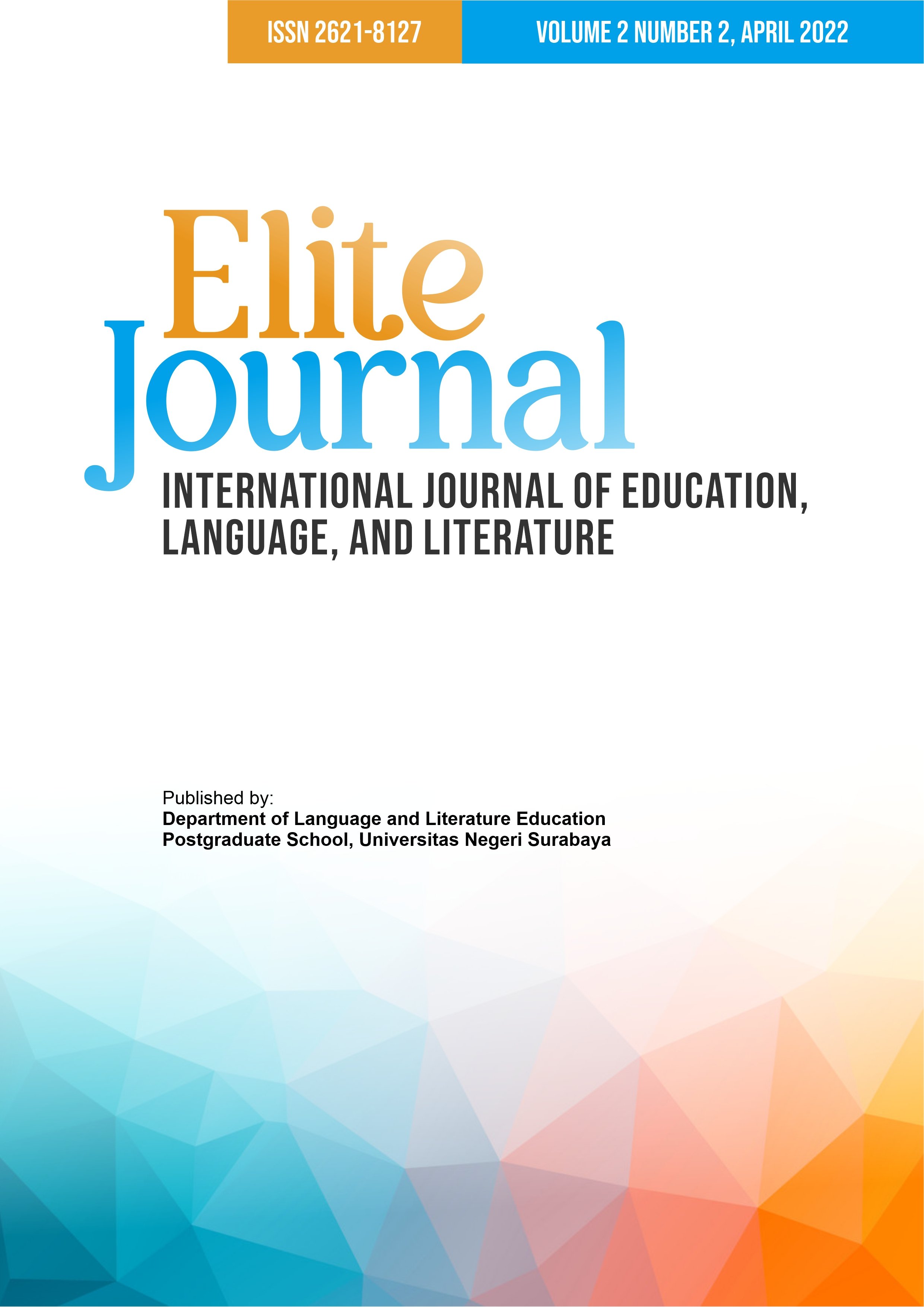STUDENTS’ PERCEPTION OF USING ZOOM MEETING FOR ONLINE LEARNING IN TEACHING ENGLISH SPEAKING SKILL IN TIMES OF COVID-19
DOI:
https://doi.org/10.26740/elitejournal.v2n2.p108-115Keywords:
zoom meeting, online learning, English speaking skillAbstract
This article examines students’ perception of using Zoom Meeting for online learning in teaching English speaking skill. Qualitative descriptive method was used to find out students’ perception related to the use of Zoom Meeting during learning speaking. The data collection used was collected by creating a questionnaire that consisted of 15 statements. The questionnaire was distributed via Google Form. The participants of this study were students of English Education Department from Singaperbangsa Karawang University which is selected randomly about 9 students from second semester students. The result showed that the use of Zoom Meeting for online learning in teaching English speaking skills give positive and negative impacts. Zoom Meeting applications make them understand some speaking class learning materials easily. However, in the other case, most of the students were bored with the implementation of online classes and lost of motivation to study during the COVID-19 pandemic only.
References
Alabbasi, D., & Ed, D. (2018). Exploring teachers perspectives towards using gamification techniquesin e-learning. TOJET: The Turkish Online Journal of Educational Technology, 17(2).
Allen, I. E., & Seaman, J. (2008). Staying the Course: Online Education in the United States. Needham MA: Sloan Center for Online Education.
Ashraf, H., Motlagh, F. G., & Salami, M. (2014). The impact of online games on learning english vocabulary by Iranian (low-intermediate) efl learners. Procedia - Social and Behavioral Sciences, 98, 286-291 . doi:https://doi.or/10.1016/J.SBSPRO.2014.03.418
Barr, D., Leakey, J., & Ranchoux, A. (2005). Told like it is! An evaluation of an integrated oral development pilot project. Language Learning & Technology, 9(3), 55-78.
Brahma, I. A. (2020). Penggunaan Zoom Sebagai Pembelajaran Berbasis Online Dalam Mata Kuliah Sosiologi dan Antropologi Pada Mahasiswa PPKN di STKIP Kusumanegara Jakarta. Jurnal Ilmu Pendidikan Nonformal AKSARA, 6(2), 97-102. doi:10.37905/aksara.6.2.97-102.2020
Brown, H. D. (2004). Language Asessment: Principles and Classroom Practices. San Fransisco: Longman.
Browne, E. (2005). Structural and pedagogic change in further and higher education: A case study approach. Journal of Further and Higher Education, 29(1), 49-59.
Butler, F. A., Eignor, D., Jones, S., McNama, T., & Soumi, B. K. (2000). TOEF 2000 Speaking Framework: A Working Paper. Chicago Educational Testing Service.
Ellis, R. (2008). The Study of Second Language Acquisition. Oxford: Oxford University Press.
Gardner, R. C., & Lambert, W. E. (1972). Motivational variables in second language acquisition. Canadian Journal of Psychology, 13, 266-272.
Gerlich, R. N. (2005). Faculty perception of distance learning. Distance Education Report, 9(17), 8.
Kabilan, M. K., Ahmad, N., & Abidin, M. J. (2010). Facebook: An online environment for learning of English in institutions of higher education? . The Internet and Higher Education, 13(4), 179-187. doi:https://doi.org/10.1016/J.IHEDUC.2010.07.003
Keengwe, J., Kidd, T. T., & Kyei-Blankson, L. (2009). Faculty and technology: Implications for faculty training and technology leadership. Journal of Science Education and Technology, 18(1), 23-28.
Lao, T., & Gonzales, C. (2005). Understanding online learning through a qualitative description of professors and students' experiences. Journal of Technology and Teacher Education, 13(3), 459-474.
Maggie, B. J., & Deniz, P. (2011). Podcasting as a Means of Improving Spanish Speaking Skills in the Foreign Language Classroom: An Action Research Study. Networks, 13(1), 1-18. Retrieved from http://journals.library.wisc.edu/index.php/networks/article/view/277
Nunan, D. (1995). Closing the Gap between Learning and Instruction. TESOL Quarterly, 29(1), 133-158.
Nunan, D. (1999). Second Language Teaching & Learning. Boston, Massachusetts: Heinle & Heinle.
Park, H. R., & Kim, D. (2017). English language learners' strategies for reading online texts: Influential factors and patterns of use at home and in school. International Journal of Educational Research, 82, 63-74. doi:10.1016/J.IJER.2017.01.002
Sellani, R. J., & Harrington, W. (2002). Addressing administrator/faculty conflict in an academic online environment. Internet and Higher Education, 5, 131-145.
Shadat, A., Sayem, M., Taylor, B., Mcclanachan, M., & Mumtahina, U. (2017). Effective use of Zoom technology and instructional videos to improve engagement and succes of distance students in Engineering. In AAEE2017 CONFERENCE, pp. 1-6.
Shumin, K. (2002). Factors to consider: developing adult EFL students' speaking abilities. In C. J Richards, & W. A Renandya, Methodology in Language Teaching, pp. 204-211.
Urdan, T. A., & Weggen, C. C. (2000). Corporate e-learning: Exploring a new frontier. WR Hambrecht Co.
Wegmann, S., & McCauley, J. (2008). Shouting through the fingertips: Computer-mediated discourse in an asynchronous environment. In K. McFerrin et al. (Eds.), Proceedings of Society for Information Technology and Teacher Education International Conference 2008, pp. 805-808.
Downloads
Published
How to Cite
Issue
Section
License
Copyright (c) 2022 Nanda Amalia Putri, Maman Suryaman

This work is licensed under a Creative Commons Attribution 4.0 International License.
 Abstract views: 1157
,
Abstract views: 1157
, PDF Downloads: 1521
PDF Downloads: 1521





